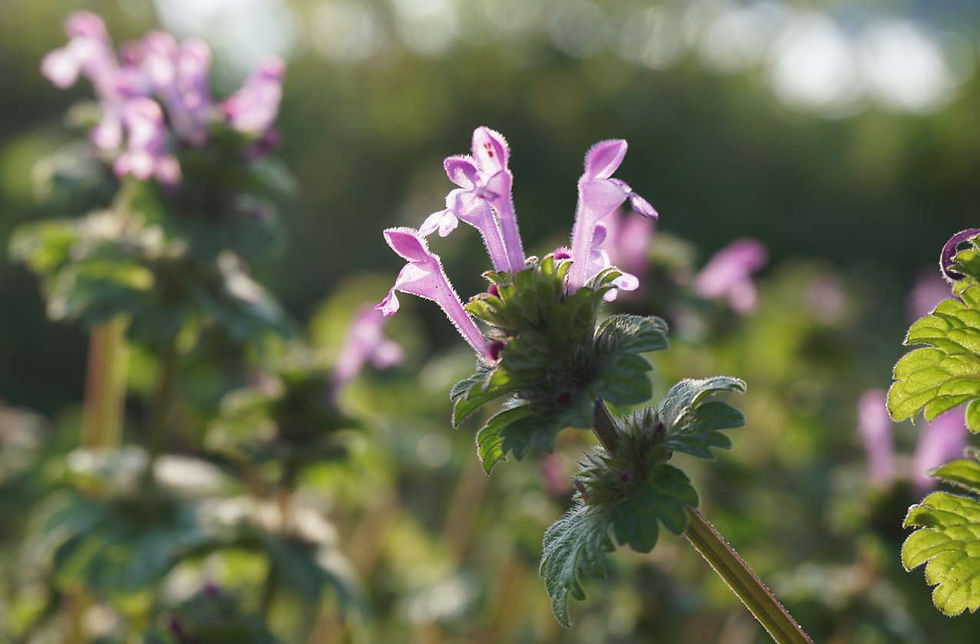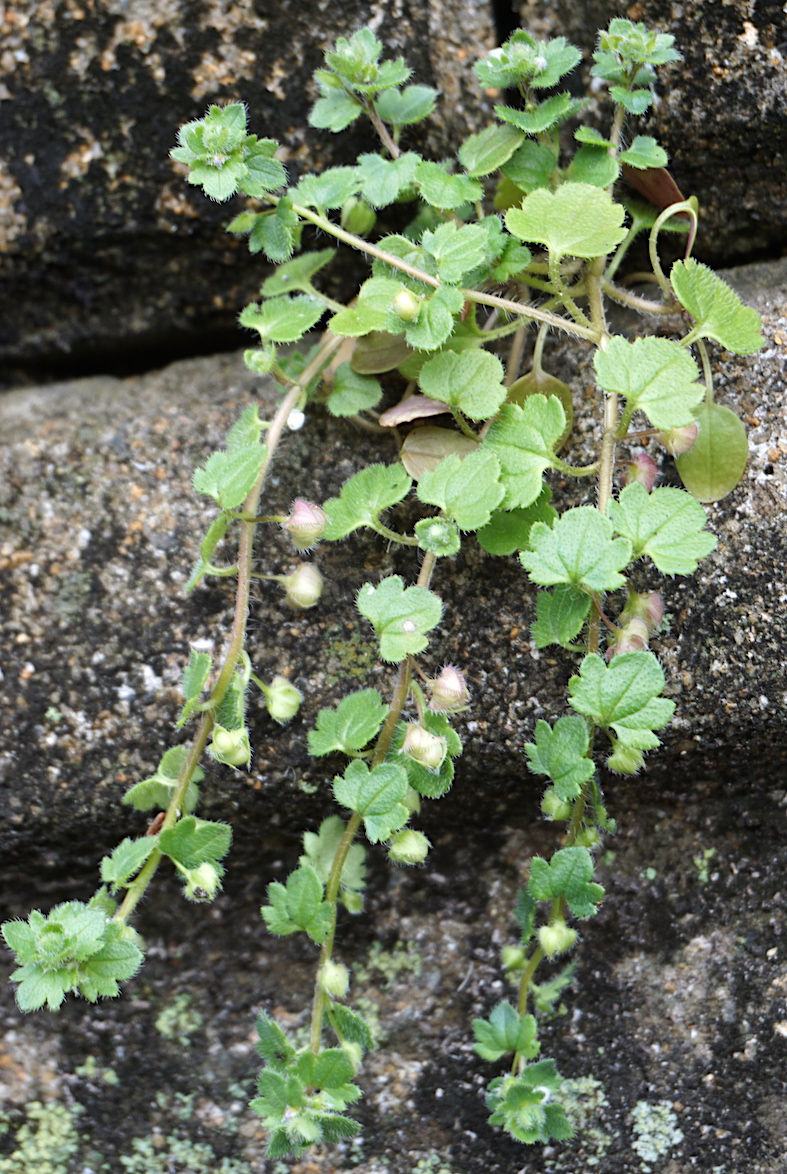愛宕の森と緑を守る会
Flowers in Atago-yama - 1
The flowers are categorized by season according to the best time to see them. Trees and others are separated, but images with flowers and fruits are also displayed by season. The species names are listed on the left and are distinguished by the color of the mark for each season, but you can click to move to the place where the image was displayed.
(Click the image to enlarge it and see the full description)
Strolling in Early Spring

愛宕山に広く分布。晩冬から早春にかけて赤い花があちこちで見られる。

仏の座。シソ科オドリコソウ属。別名、サンガイグサ(三階草)。一年草ないし越年草。道ばたに広く分布。茎を取り巻く半円形の葉の形が蓮華座に見えるので命名された。花を吸うと蜜がおいしい。春の七草の「ほとけのざ」とは別種(キク科のタビラコ=田平子、あるいはコオニタビラコ)。

アブラナ科アブラナ属。4枚の花弁の形から、昔は十字花科とも言われていた。アブラナは弥生時代に中国から、セイヨウアブラナは明治初期にヨーロッパから入り、名前のとおり菜種油を採取していたが、最近は食用、観賞用も多い。容易に交雑し変種が多く、分類は困難。食用で移入されたセイヨウカラシナの花弁の形は十字形というよりH形。

愛宕山の北側斜面、愛宕山観光道路脇に2本のカワヅザクラ(河津桜)が植えられている。(2016.03.05撮影)

カワヅザクラはソメイヨシノに先駆けて濃いめのピンクの花を開く。 伊豆半島の河津町で発見されたのが名の由来。オオシマザクラとカンヒザクラの自然交配種。


Strolling in Spring and in Early Summer
Gentiana zollingeri

筆竜胆。愛宕山に咲く希少種。大切にしていきたい貴重な花で、春、1本の茎に数輪の鮮やかな花を付ける高さ数〜10センチの可憐な�小さい花です。日があたると開花し、曇ると閉じ、夕方にも早々と寝てしまいます。

今年も咲きました。フデリンドウが咲く環境を守っていかないと、簡単に絶滅する危機的状況にあります。福岡では未指定ですが、数都府県で絶滅危惧種に指定されています。

間もなく開花。今年見つけた最多の蕾数。1本で20ほど。ハルリンドウに似ていますが、ハルリンドウは茎1つに花1つ。

フデリンドウの可憐な花は、陽が出ている時にのみ開花します。花の色は、ひとつひとつの花ごとに、あるいは株ごとに、微妙に異なっています。

この画像だけを見ると、絶滅の危機にあることを忘れてしまいます。しかし現在、愛宕山でこのようなフデリンドウを見ることができるのは、わずか数メートル四方の、この場所だけしか残っていないのです(現在は、この他にもう1カ所で確認できています)。

フデリンドウは咲き終わると「筆先」に豆粒のような形の実をつけます。

種子を包む蒴果(さくか、子房)は雨天の際に開いて、中にある種子を雨水で周りに流します。この画像は曇天で半ば開いた状態で撮ったものです。左側の3つは、頭を虫にかじられています。

雨上がり直後のフデリンドウです。蒴果が全開しています。

晩秋になると新たな芽が育ち、翌春の開花をめざして厳しい冬を越す。

展望台のある大山祇神社跡公園は、かつてはフデリンドウの群生地でした。工事による改変で今は見る影もなく、フデリンドウは整地箇所の周りにわずかに残っていますが、外来植物に覆われ、放置しておくと消滅しかねません。フデリンドウが適応できる条件は適度の木漏れ日があり、他の草が茂らないような環境に限られます。
Brush gentian. Gentianaceae Gentian genus. Annual grass. The shape of the bud is the origin of the name. A rare species that blooms on Mt. Atago. It is a precious flower that you want to cherish, and it is a pretty flower with a height of several to 10 cm that attaches several bright flowers to one stem. It blooms in the sun, closes in the cloud, and falls asleep early in the evening. When the flowers are finished, "capsules, capsules" like beans are produced on the "brush tip". This capsule, which is filled with seeds, closes when it is sunny and opens when it rains, contrary to the petals. Gentiana's strategy of sowing seeds using rainwater while protecting the seeds from drying out.
In autumn, new buds emerge from the gaps between the dead leaves, and we spend a harsh winter until the next spring blooms.
Corydalis incisa

紫華鬘。ケシ科。日本全国に分布。木陰に育つ高さ30~50センチの草で、有毒。食すと嘔吐、昏睡、呼吸麻痺�、心臓麻痺など。山菜のシャクと葉が似ているので要注意です。ウスバシロチョウの幼虫の食草で、結果、親も有毒になり、鳥の捕食から避けられる。

4~6月に2センチほどの筒状の花が咲き、早々と実をつけます。花の形が仏具の「華鬘」に似ているのが名前の由来との事ですが、実物を知らないので、なんとも・・・。

実は熟すと果皮がくるんと捲れて種子をはじき飛ばします。
Corydalis incisus. Poppy family Corydalis. Distributed all over Japan. It is a grass with a height of 30 to 50 cm that grows in the shade of a tree and is toxic. Vomiting, coma, respiratory paralysis, heart attack, etc. when eaten. Be careful as the leaves are similar to the cow parsley of wild plants. The herb of Parnassius glacialis larvae, as a result, also poisons parents and avoids bird predation.
Seeds produced in early summer germinate and grow in the spring of the following year. After that, the above-ground part withered and only tubers remained underground, and in autumn, they sprouted again and overwintered with several leaves. In spring, the flower stalks are extended and bloom, and wither after fruiting. It is a flower that spends a rare life of 3 years.
Dandelion

よく知られた要注意外来生物。「侵略的侵略的外来種ワースト100」の代表格。強靱で在来種のニホンタンポポを駆逐、あるいは交雑して、どこにでもはびこってしまいました。花ビラの下の総包(緑色)の外片が反り返っている点に注目。

愛宕山でも在来種のタンポポを確認できました(種名未同定)。総包(緑色)の外片の反り返りがありません。残念なことですが数が少なく、精査しないと見つけることは困難です。

ひとつの花に見えますが、他のキク科と同様、舌状花と呼ばれる小さな花が円盤状に集合しているもの。カギ状に見えるのが、それぞれの雌しべ。

在来種。西日本に広く分布しているタンポポ。

黄色の割合は多種多様。
dandelion. A general term for the genus Dandelion in the family Asteraceae. In the old days, it was also called Fujina, Tana, Tsuzumigusa (drum grass), etc. Perennial, the roots reach 50 cm to 1 m and are strong and spread all over the world. Like other Asteraceae, dandelions are a collection of small flowers called tongue-shaped flowers that look like a single flower (head-shaped inflorescence), and when they become seeds, each one is fluffed and blown by the wind. To go. Native dandelions are overwhelmed by the tough common dandelion, which is said to be the representative of the "100 Worst Invasive Alien Species", and has decreased to the point where it is rarely seen, especially in urban areas. Most of the dandelions on Mt. Atago are common dandelions, and it is difficult to find native dandelions. The biggest difference is whether or not the outer piece of the bract (green) under the flower villa is warped, and it is the common dandelion that is warped. There are quite a few hybrids. The native dandelions vary slightly depending on the distribution area, and are classified into more than 20 species such as Ezo dandelions, Taraxacum platyphylla, Taraxacum platyphylla, and Taraxacum platyphylla . Taraxacum albidum is a native species, but the proportion of white and yellow flowers varies. By the way, "Japanese dandelion" is not a species name, but a common name for all native species.
It is used worldwide as a medicinal herb and is also used as an edible product such as herbal tea, which is expected to have a diuretic effect, salads, and stir-fried oil. In Chinese medicine, it is widely used for decoction of dried foods, relieving constipation and indigestion, breastfeeding, antipyretic, and stomachic medicine.
Other flowers

金瘡小草。別名ジゴクノカマノフタ。日当たりの良い道端、石垣に這うシソ科の多年草。花期は3~5月で、この時期は「筋骨草」という名の生薬(高血圧、鎭咳、解熱、下痢止め等)として用いられます。揉んだ茎葉は虫さされや外傷などに効く。

愛宕山ではヒメツルソバなどに追いやられて減少しています。愛宕神社直ぐ下の道路脇のコンクリート擁壁では増殖中。

ヒマラヤ原産のタデ科の多年草。別名カンイタドリ。明治時代にロックガーデン用に導入された。初夏から晩秋にかけてピンクの金平糖のような花が長く咲き、紅葉も美しいので園芸種として人気があり、グラウンドカバーとしても用いられている。しかし極めて強健で繁殖力が強いため、野生化して、キランソウを始めとした在来種を駆逐する侵略的外来種。

コンクリートの隙間や石垣などに広がり、地表部が枯れても写真にあるような長い根があるため、絶えることはない。70〜80センチはあるだろうか、駆除するのはたいへんな作業。

立坪菫。スミレ属は品種、変種が多く、その中でもタチツボスミレは日本産スミレを代表する種で、さまざまな環境下で育ち、広く分布している。

都会の道路の縁や溝などで一般的に多く見られるスミレ(言わば、ど根性スミレ)と異なる点は茎が立ち上がり、そこからも葉や花茎を出す。スミレは地下茎からのみ出す。また、タチツボスミレはスミレより花の色が薄い。

踊子草。虚無僧花(こむそうばな)とも言う。花期は4~6月。ピンクまたは白色の花は、笠をかぶった踊り子達の姿に見えるので名が付いた。草丈は30~50センチ。これに似た、より小型のヒメオドリコソウは外来種。愛宕神社下の大駐車場脇にオドリコソウ群生地がある。

花の基部に蜜がある。若芽はお浸しにして食べられる。

垣通し。シソ科カキドオシ属。別名、カントリソウ。4~5月に花が咲く多年草。茎は蔓状に伸びて横に這い、根を張る。垣根をくぐり抜け、隣に侵入するので、この名が付いた。茎や葉を揉むと芳香がする。乾燥させて連銭草という生薬に。小児の疳の虫に用いた。このことが別名の由来になっている。 ヨーロッパ原産で同種の斑入りのものがグレコマ(属の学名)という名称で園芸店で売られている。主にグラウンドカバーやハンギングにし、ハーブとしても利用される。

草苺。バラ科キイチゴ属の落葉小低木。花期は3~4月で白い花は良く目立つ。高さが20~40センチと低いため、草と見間違えられ、名称の由来に。

初夏に稔る赤い果実は酸味が少なく甘くて美味しい。

樒。マツブサ科シキミ属の常緑高木。別名、仏前草、しきび。「抹香の木」とも言われる。有毒で、死亡事故も起きていて、劇物に指定されている。春に淡黄色の花が咲き、抹香の香りが強く漂うが、茎、葉、果実にも香りがあり、線香などに用いられる。仏事に欠かせない木であるため寺院に多く見られ、愛宕山では観音密寺本堂脇の奥の方に植えられている。

吸い葛。常緑つる性木本。花の蜜を吸うと甘いのでこの名が。英名でも honeysucleと、同じ。昔は砂糖がわりに使われた。常緑性で、冬も青いのでニントウ(忍冬)という別名も。花は5-7月に咲き、白から黄へと色が変化。そのため、金銀花という名の生薬(抗菌、解熱)として蕾が使われている。アメリカをはじめ、海外ではクズに次いで有害な外来種に。

草の黄、あるいは草の王、蒼の王。ケシ科クサノオウ属。ユーラシア大陸に広く分布する種で、東アジアに分布するものはヨーロッパ産の変種とされている。花期は4~7月。莢の中にできる種子にはエライオソーム(種枕)という付着物を伴い、それがアリの好物で巣に運ぶため、種子が拡散される。種子は秋に発芽し、根本から放射状に葉を出すロゼットを形成して翌春に40~80cmの草丈に成長する越年草。

傷をつけると黄色い乳液が出るが、これは有毒(アルカロイド系)で、皮膚に付くと炎症をおこすので要注意。皮膚の弱い人は草に触れるだけでもかぶれる。また、薬草としても用いられ、茎・葉を乾燥させたものを白屈菜といって水虫などの皮膚疾患、外傷の手当に用いる。煎じて服用し、鎮痛剤や下剤、アヘンの代用品としても使われた。しかし毒性が強く、現在は用いられていない。

地縛り。キク科ニガナ属の多年草。別名、イワニガナ(岩苦菜)。全国に分布し、花期は4~7月。根が地面を這うように拡がり、地面を縛っているように見えるので、この名に。葉は楕円形だが、花は一見、「一重のタンポポ?」と思わせる姿をしている。

花びらのように見える1枚1枚がそれぞれ1つの花で、「花」はその集合体。これは舌状花というキク科に特徴の構造。花茎が5~15cmほど上に伸び、途中で2~3に枝分かれ(茎分かれ?)することもある。

姫烏頭。キンポウゲ科ヒメウズ属の多年草。有毒。地下茎(塊茎)を持つ。オダマキの近縁で、3~5月に小さい花をつける。トリカブト(烏頭)に似た小さい草ということで、この名前に。

ヒメウズは有毒。別名、トンボソウ(蜻蛉草)。花をトンボ釣りに使ったからとのこと。

風藤葛。コショウ目コショウ科コショウ属。つる性木本で雌雄異株。別名ツルゴショウ。愛宕山では多く自生している。暖地の海岸に多い。これは雌株。

花期は4〜5月。雌株。穂状花序は4〜8センチ。粒々に多数見えるのがそれぞれ小さな雌花。花の色は白(?)ですが、葯が黄色なので全体には黄色に見えます(未熟時は緑色)。

雄株。日本本土における唯一のコショウ科の種。この他、小笠原母島にツル性ではないタイヨウフウトウカズラ(絶滅危惧IA類)がありますが、自生株はたった1株しかないとのこと。

緑繁縷。ナデシコ科ハコベ属の越年草。旧名ハコベ。どこにでも見られるハコベ。花期は4〜5月。花柱は3本で、花弁が重なり合っている。茎は緑色だが、良く似たコハコベの茎は暗緑色。

耳菜草。枕草子では「耳無草」。ナデシコ科ミミナグサ属。ハコベの近縁種。外来種のオランダミミナグサに圧迫され希少種に。全体に細かい毛が生えている。オランダミミナグサとの違いは、花柄の長さが長いこと、がく、茎が暗紫色(オランダミミナグサは淡緑色)であることなど。花数が少なく、全体として、すっきりした印象に。

和蘭耳菜草。別名、アオミミナグサ。ナデシコ科ミミナグサ属。ハコベの近縁種。ヨーロッパ原産の外来種。在来種のミミナグサを圧迫しつつあり、ミミナグサは希少種に。花柄が短い、花弁が萼より長く、花がかたまって咲くので、ミミナグサとの区別がつく。

野襤褸菊。キク科ノボロギク属。別名、オキュウクサ、タイショウクサ。ヨーロッパ原産で明治期に入った外来種。繁殖力が強く、全国に広がる。

開花期は5〜8月だが、温かい地域では通年で咲く。筒状花で7mmほどの冠毛がある。

山吹。バラ科ヤマブキ属の落葉低木。日本原産で全国に生えている。花期は4〜5月で、花弁が5枚の山吹色の花が株一面に咲く。というか、「山吹色」はこの花の色が元。

八重山吹。ヤマブキの古くからの園芸品種。太田道灌の逸話で有名な「七重八重花は咲けども山吹の実の(蓑)一つだになきぞ悲しき」(兼明親王、後拾遺和歌集、1086年)にあるように、八重咲きのヤマブキには実がならない。

花満開の桜坂。旧唐津街道から観音密寺へ向かう参道の入口付近。

参道登り口から石段の途中にある観音密寺までの間は、ソメイヨシノ開花の僅かの間、桜のトンネルに。

観音密寺境内では立派なソメイヨシノが咲き誇ります。

かつて鷲尾城があった場所は、知る人ぞ知る、隠れた花見スポット。ソメイヨシノの他に、ヤマザクラも混ざって咲きます。

ソメイヨシノは咲き始めの花弁の色が白いが、散りぎわに近づくにつれ、中心部付近がピンク色となり、だんだん濃くなっていく。

ソメイヨシノの葉の基部には蜜腺という器官が一対あり、そこから爽やかな甘さの蜜を出します。微量ですが、若い枝に出やすいようです。他のサクラの蜜腺は、通常、葉から離れた葉軸上にあるので、区別できます。アリを引き寄せて、他の害虫から守る働きをすると考えられています。

蕨。コバノイシカグマ科ワラビ属の多年生シダ植物。陽当たりの良い場所に生える。牛などの家畜が摂取するとワラビ中毒を起こし、重症になると死亡することもある。ワラビの地下茎から良質のデンプンが採れることは縄文時代から知られている。

葉が開く前の若い芽は代表的な山菜だが、食べるにはアク抜きが不可欠。

薇、銭巻。ゼンマイ科ゼンマイ属。日本全国から中国、ヒマラヤまで分布し、雑木林内などの陽当たりの良いところに生育する。渦巻き状に立ち上がる新芽は綿毛に包まれているが、その後、毛は消失する。葉は胞子葉(男ゼンマイ)と栄養葉(女ゼンマイ)と2種類あり、山菜採りでは5月頃に栄養葉の新芽を根元から採り、軸を茹でてアク抜きし、和え物やお浸し、佃煮、煮物等にして食べる。根茎は利尿や補血の生薬として用いられる。綿毛を集めて紡ぎ、ぜんまい綿として用いられた。

山菜採りでは、こちらの栄養葉(女ゼンマイ)を採る。

刺実の狐の牡丹、あるいは刺実狐牡丹。キンポウゲ科キンポウゲ属の越年草。別名トゲミキンポウゲ。ヨーロッパ原産の外来種で、1915年に仙台市で見いだされたが、繁殖力が強いため、その後全国、主として西日本に広がる。

花期は4~6月。花弁の基部に蜜腺がある。キツネノボタン、ケキツネノボタンなど、きわめて似ている種が多い。

球形の集合果の実に刺状突起があるのがこの種の特徴。

野薊。キク科アザミ属の多年草。鋭い棘の葉が特徴。日当たりの良い野原や土手に普通に見られるが、愛宕山では極めて希少種となっていた(全体で2株のみ)。育苗し、現在増えつつある。

花期は5〜8月。花の色は紫だが、まれに白色もある。良く似た種としてノハラアザミがあるが、これの花期は秋。

フラサバ草。オオバコ科クワガタソウ属の越年草。別名、ツタバイヌノフグリ。ヨーロッパ原産の外来種で、明治初期に長崎県で確認され、現在は全国に分布。

花期は4〜5月。名前の由来は2名のフランス人植物学者の名前(フランシェ、サバティエ)から。


藪人参。セリ科ヤブニンジン属の多年草。藪に生え��、葉がニンジンに似ているのが名前の由来。 林の縁、竹やぶなどの日陰に生える。ヤブジラミやオヤブジラミ、セントウソウに似るが、葉の形や果実の形状が異なるので区別できる。

花期は4~5月。果実は2つに分かれ、2cmほどの細長くて棒状の硬い果皮が2本並ぶ。根茎を乾燥させて「和藁本(わこうほん)」という名の生薬に。頭痛、腹痛などに用いられる。























